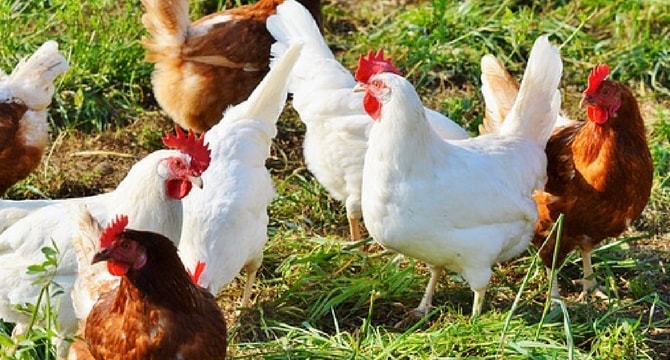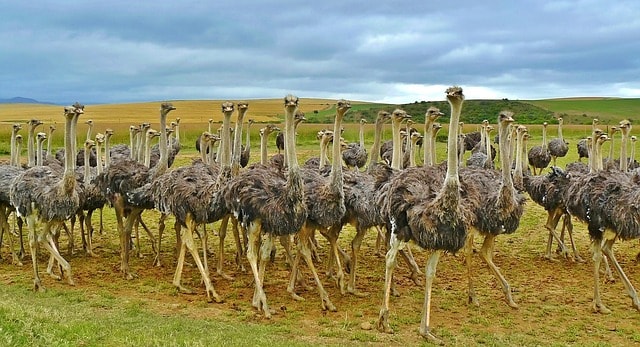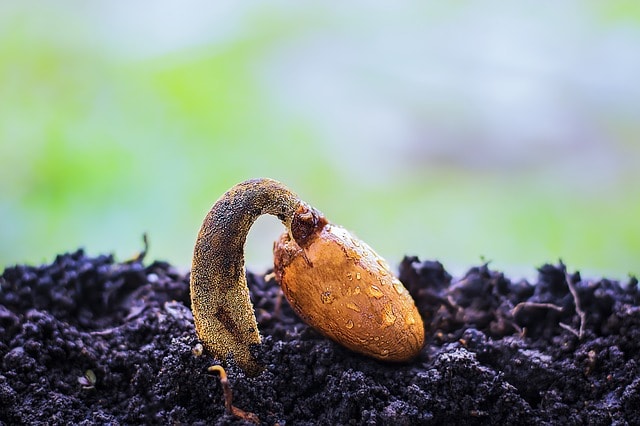Starting Poultry Farming For Meat & Eggs Production – Profitable Business Plan

As long as the global demand for fresh and hygienic eggs and meat refuses to wane, poultry farming will continue to sustain as a profitable business! Here in this article I will share useful information on how to start your own poultry farming business. Poultry farming is the process of raising birds such as ducks, chickens, turkeys and geese for the purpose of farming meat or eggs for food. Here in this article I will discuss about chickens.
Requisites for Housing (Shed Construction)
Your chickens must be happy if your business is to thrive. Therefore, you must ensure that they live in well-ventilated, well-lighted, clean and vermin-proof houses. They must receive protection against predators, uncomfortable weather conditions and sesonal diseases. At the time of construction of shed make sure that you consider minimum area of 2 to 3 sqft per chicken inside the shed, and 9 to 10 sqft per chicken for outside run.
Extensive or Free Range Housing
- This centuries-old method is most suitable where vast tracts of land or sufficient spaces containing seeds, insects and herbage are available.
- Keep this external space well sanitised and safe, for parasitic infestations, infectious diseases and predators are eternally waiting to make an entry.
Semi-Intensive Housing
- In this case, space is limited, but not overly so.
- You might divide the land on either side of the henhouse in such a way that each bird gains access to 8 – 10 square yards of area.
Folding Unit Housing
- In this portable system, the 25 or so birds staying in a single residence (20 x 5 feet), gain access to just one small run for the day.
- Each bird owns one square foot of space within the house, and three square feet outside it.
- The position of the run changes the next day, in order to provide healthy and fresh herbage.
- Your land benefits too, thanks to the constant scratching and manuring services offered by the birds!
Intensive Housing
You will have to go for this if you possess limited land and cannot afford to purchase more. As a result, your birds will have to suffer imprisonment always.
(a) Battery Cage System
- Every bird has her own cage, wherein she is able to sit and stand comfortably in the 14 x 16 inches of space available to her.
- The height of the cage is 17 inches.
- Made of strong and standardised, galvanised wire, the floor slopes downwards, such that freshly laid eggs roll into a conveniently placed gutter.
- The hen’s droppings land in a tray placed underneath the cage.
- She may eat and drink from the food and water receptacles placed directly outside her cage.
- You must provide vitamins D and A via dried milk powder, cod liver oil and yeast, along with nutrient-rich mash.
- The birds also need some manner of grit, fishmeal (or other animal proteins) and minerals.
(b) Deep Litter System
- You will have to house at least 250 birds in a large pen.
- The floor must have gradual build-up of litter, measuring eight to 12 inches in depth.
- The litter comprises of leaves, straw or saw dust.
- Just ensure that no moisture enters the litter, for pests and diseases must not make an entry.
- The expanded metal or strong wire netting of the pen keeps the birds safe.
- The litter fulfils some of the nutrient requirements too. A major asset is riboflavin, the quantity of which increases threefold.
- A dry and well-maintained litter will not require regular cleaning.
- The birds’ droppings are useful as fertiliser or manure.
- The litter is akin to a burrow for providing coolness, whenever the temperature rises above the comfort level.
Poultry Farming for Eggs Production
You may like to go in for commercial egg production, instead of raising birds for meat. Then, you would be launching a Layer Poultry Farming Business. In fact, the hens belong to unique species/breeds, well known for producing large numbers of eggs each year.
Selecting Hens
Note that not all hens will lay the same amount of eggs; each breed differs. Then again, if you were keen to purchase chicks, approach a well-known and reputed hatchery.
- Those hens, which lay brown eggs, consume more food and are large. Even their eggs, with their brown-coloured shells, are larger in comparison to the eggs produced by other breeds.
- Those hens, which lay eggs with white-coloured shells, are not heavy eaters. They are smaller in comparison to the brown egg-laying hens.
Looking after the Chicks
- When the nest is full, the hen goes into incubation mode, wherein she refuses to drink or eat normally. She is being ‘broody’.
- Keep the chicks in separate quarters soon after they hatch.
- Give them protein-rich and energy-rich chick starter feed.
- Add 2% calcium two weeks later, to the feed.
- Until they are 18 weeks of age, feed them a couple of times, or even thrice a day.
- Add necessary supplements, until they reach the egg-laying stage.
- Keep a regular check on their weights.
- Since growing chicks refuse to drink water on their own, you will have to train them to drink fresh, pure and clean water.
- Supply warm water during the cold season and cold water during the hotter.
- Add 5% glucose to the water, multivitamins or electrolytes, to prevent tiredness, especially during transportation.
- When you move 16-week-old or 18-week-old pullets into their egg-laying quarters, they settle in, prior to the advent of sexual maturity and egg production stage.
Beak Trimming
Beak trimming is common in egg-laying chickens. It is performed early in the life of chicks to decrease chances of injuries caused by cannibalism, bullying, and feather and vent pecking. In some countries such as the United States, 80% chickens and turkeys have their beaks trimmed routinely, however, in the UK, only 10% of chickens and turkeys have their beak trimmed. Beak trimming is done to prevent chickens from injuries.
A machine known as “Debeaker” is used for beak trimming. Some says that it is traditional method with no benefits, it is a senseless act of cruelty. But farmers in USA, Europe and India still uses this method.
If you are planning to cut beaks then follow the below guidelines:-
- Wait for eight to ten days after their birth, before you trim the beaks of your chickens.
- Trim again, after they reach 8 to 12 weeks of age.
- Serve them vitamin K-enriched water three days prior to every process.
- The expert technician must cleanse the block chick-trimming machine with antiseptic, test the temperature of the blade and examine its edges.
- Without causing damage to the tongue or eyes, trim the days-old chick’s beak, just 0.2 cm from the nose.
- The distance must be 0.45 cm for the growing chicken.
- Trim the upper and lower lips, one after another.
- Serve the bird water in a deep pot, as well as energy-enriched food.
Avoid beak trimming during adverse weather conditions, during the egg-laying period, or when the bird is in a strain. Avoid the same if the pullet is on medications (especially, containing sulphur), or the chick is due for vaccination.
- Timely and stress-free vaccinations with well-sterilised equipment are imperative.
- Cold weather conditions prove more conducive.
- Do not vaccinate infected/ill birds.
Looking after the Adults
If you give them nutrient-rich feed and house them in a residence with a temperature of 21 to 28oC, at least 5% of 20-week-old hens should begin laying eggs. By the time, they reach 26 to 30 weeks of age, egg production climbs greatly!
The hens keep growing until 40 weeks of age. Until they reach the age of 50, they will provide you with large-sized and well-weighted eggs.
Collect and store the eggs regularly. Have a separate egg room for checking for damages and weight, as well as for grading. Store the graded eggs in a room possessing a temperature of around 13o. Use an insulated truck for transporting them to the marketplace.
Poultry Farming for Meat Production
When you adopt broiler poultry for your business, it indicates that you wish to sell them as meat.
Housing Conditions
- It would be best to maintain a distance of 35 to 40 feet between a house placed in the east-west direction and another.
- Every chick requires a space of 2.5 cm, until it is one week of age.
- Use a blowlamp to rid the house of insects, such as mosquitoes, lice, etc.
- Your chicks will feel comfortable, if the temperature of the house is around 35 degrees centigrade.
- Thereafter, it should reduce at the rate of 2.80 degrees centigrade each week.
- Ensure that your chicks can wallow in litter, which is five to six inches in depth.
- Keep straw in the chicken bed.
- You will need to clean the bed a couple of times a week, with the aid of a spade.
- In case, you find it to be too damp, use lime to absorb all the ammonia gas in the atmosphere.
Caring for the Chicks and adults
- Select one-day-old chicks, each of which weighs between 36 and 40 g.
- Until the chick reaches six weeks of age, provide feed containing protein, amino acids (lysine and methionine), fibre, etc.
- Request a professional to help you out with feed management, during the initial stages.
- Vitamin supplementation (A, B2, B12, D3 and K) is essential.
- Give a combination of manganese sulphate, potassium, zinc carbonate and iodine separately.
- The chicks must receive feed at least four times a day, during their growing years.
- Add some edible disinfectant to the feed for your broiler poultry, since they need to be free from infections and diseases.
- Supply plenty of clean and fresh water. Give warm water during the cold season.
- These breeds drink plenty of water, especially during the summer season.
- They eat all the time, especially during the winter season.
Ensure timely vaccinations.
FAQS
The most important factors to consider when starting a poultry farming business are the type of poultry you plan to raise, the amount of land you have available, the climate in your area, and the amount of money you have to invest. You will also need to decide whether you plan to raise chickens, ducks, or turkeys.
There are many ways to market and sell poultry products. Some producers sell their products directly to consumers through farmers markets, roadside stands, and community-supported agriculture programs. Others sell to wholesale markets, such as restaurants, grocery stores, and food distributors. Poultry products can also be sold through online marketplaces.
There are a number of challenges faced by poultry farmers, including:
1. Ensuring the health and welfare of their birds
2. Meeting strict food safety standards
3. Managing costs associated with housing, feed, and labor
4. Keeping up with changing consumer preferences
5. Addressing environmental concerns
The most common diseases that affect poultry are coccidiosis, salmonella, and avian influenza. Coccidiosis is a parasitic disease that is prevented by vaccination. Salmonella is a bacterial disease that is prevented by good sanitation and biosecurity practices. Avian influenza is a viral disease that is prevented by vaccination and biosecurity practices.
Poultry should be housed in a clean, dry, and well-ventilated environment. The housing should be designed to protect the birds from predators, inclement weather, and excessive heat or cold.
1. A clean and dry environment will help to prevent the spread of disease and parasites. The housing should be cleaned and disinfected on a regular basis.
2. The birds should have access to fresh water and a nutritious diet. A poultry health program should be implemented to prevent and control diseases.
There are a number of ways to humanely slaughter poultry. The most common method is to use a sharp knife to quickly and efficiently sever the jugular vein. Other methods include using a captive bolt pistol or electric stunner.
There are many ways to add value to poultry products. One way is to process the poultry into value-added products such as chicken nuggets or pre-cooked chicken breasts. Other ways include branding, packaging, and labeling the poultry products in a way that makes them more appealing to consumers.
Some of the latest trends in the poultry industry include production practices that aim to reduce the use of antibiotics, as well as the use of technology to track the health and welfare of poultry. There is also a growing demand for higher-welfare poultry products, as well as for products that are free from hormones and other additives.
Some of the challenges associated with poultry farming in the developing world include: 1. Poor infrastructure and lack of access to technology and information
2. Lack of capital
3. Disease
4. Pest and predator pressure
5. Geographical isolation
6. Political instability
Some of the opportunities associated with poultry farming in the developing world include:
1. The potential to improve nutrition and livelihoods
2. The potential to create employment and economic opportunities
3. The potential to improve incomes
4. The potential to contribute to food security






